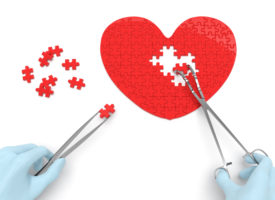“I know you generally recommend against bypass surgery and angioplasty. I was pressured into having an angioplasty and was not given any other options. What do you suggest for someone such as myself?” — W.S., Arizona
This is a good question, and one I often overlook when discussing the pros and cons of invasive cardiovascular procedures.
Bypass and Angioplasty Are Not Cures
First, you need to understand that neither bypass or angioplasty “cures” or changes the course of heart disease. Atherosclerosis, the underlying cause of coronary artery disease, affects blood vessels throughout the body. Bypassing one or two arteries or propping them open with stents does nothing to slow or curb the progression of cardiovascular disease.
In fact, the large, calcified plaques and blockages visualized on angiograms and targeted by heart surgeons aren’t the primary problem. Most heart attacks are caused by smaller, unstable plaques, which rupture and form blood clots that block blood flow to a coronary artery.
That’s why, except for a small subset of patients, bypass and angioplasty are no better at preventing future heart attacks or saving lives than medications and other conservative treatments. Reductions in angina and other symptoms are the best that can be expected, but similar improvements can also be achieved through safer, noninvasive therapies.
A Heart-Healthy Lifestyle
That said, you can’t turn back the clock—but you can take steps to slow the progression of cardiovascular disease. Lifestyle changes are far more powerful than most doctors give them credit for.
In a 2015 study, Harvard researchers evaluated the impact of a healthy lifestyle on heart attacks and cardiovascular risk factors. They looked at 20 years of data on nearly 70,000 women and six healthy habits: a good diet, no smoking, normal weight, two and a half or more hours of activity per week, seven or fewer hours of TV weekly, and no more than one alcoholic drink per day. The study participants who followed all six had a 92 percent lower risk of heart attack and a 66 percent reduced risk of type 2 diabetes, hypertension, and abnormal blood lipids.
If adopting all of these lifestyle changes seems overwhelming, working on just one at a time is a step in the right direction. The researchers found that healthy weight, regular exercise, a good diet, and smoking cessation were each independently protective.
Supplements for Cardiovascular Health
In addition to lifestyle changes, I also recommend targeted nutritional supplements. At Whitaker Wellness, we prescribe each of our patients a personalized supplement program that engenders multiple aspects of arterial health, starting with an antioxidant- and B-vitamin-rich daily multivitamin and adding some or all of the following:
- Magnesium (500–1,000 mg) to relax the arteries
- Coenzyme Q10 (100-300 mg) and L-carnitine (2-4 g), which energize the cardiac muscle and enhance heart function
- Fish oil (1-2 g EPA/DHA) for its many cardiovascular benefits
- Vitamin D (2,000-5,000 IU), which is associated with lower risk of heart disease
- Pycnogenol (100 mg) and other nitric oxide boosters that dilate the arteries and improve arterial health
- Citrus bergamot (500 mg), red yeast rice (500-1,200 mg), and/or supplemental fiber for lowering lipid levels
- Berberine (1,500 mg) for insulin resistance and diabetes, which are significant cardiovascular risk factors
EECP for Treatment and Prevention
The most powerful noninvasive therapy for cardiovascular disease is enhanced external counterpulsation (EECP). Safe, well tolerated, and relatively inexpensive, EECP has been shown in dozens of clinical trials to reduce angina, increase exercise tolerance, and dramatically improve quality of life.
EECP should be the first-line treatment for symptomatic coronary artery disease. In my opinion, doctors should order it before bypass and angioplasty and resort to those invasive therapies only if EECP doesn’t help. Unfortunately, it’s offered only to patients who have either failed or are considered unsuitable candidates for these intensive procedures.
Because EECP has lasting effects on arterial health and function, it is also a terrific preventive treatment. In addition to reducing arterial stiffness, it increases the production of nitric oxide, which dilates the arteries and improves circulation. EECP also promotes the release of regenerative stem cells, which repair damaged areas and stimulate the growth of new blood vessels around arterial blockages. I’m such a believer in the protective properties of EECP that I’ve had well over 100 treatments myself, even though I’ve never had any signs or symptoms of heart disease.
Beware of Unintended Consequences
There’s a concept in social sciences called the law of unintended consequences, which means that actions always have unanticipated or unintended effects. They could be positive benefits, drawbacks in addition to desired outcomes, or results that are completely contrary and averse to their intended purpose.
It is my clinical experience that many patients experience a significant unintended consequence from coronary artery bypass and angioplasty. Because they have been led to believe that these interventions save lives and prevent heart attacks, they somehow feel immune from future cardiovascular problems. Therefore, they are less likely to eat right, exercise regularly, watch their weight, and embrace other lifestyle changes.
Nothing could be further from the truth. Whether you’ve had an angioplasty/bypass or not, if you’ve ever had any signs or symptoms of cardiovascular disease, you need to be thinking prevention. Here at the clinic, we help our patients adopt lifestyle changes, prescribe an individualized nutritional supplement program, and, for optimal protection, recommend a course of EECP.
Does it work? Just ask our many patients who have opted for this approach—and soundly defied their doctors’ dire predictions. To learn more, read their stories here or call 800-488-1500 to speak with one of our friendly and knowledgeable Patient Services Representatives.


